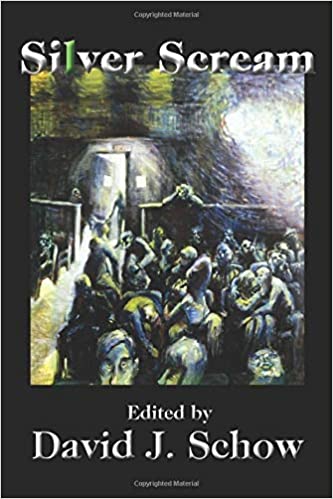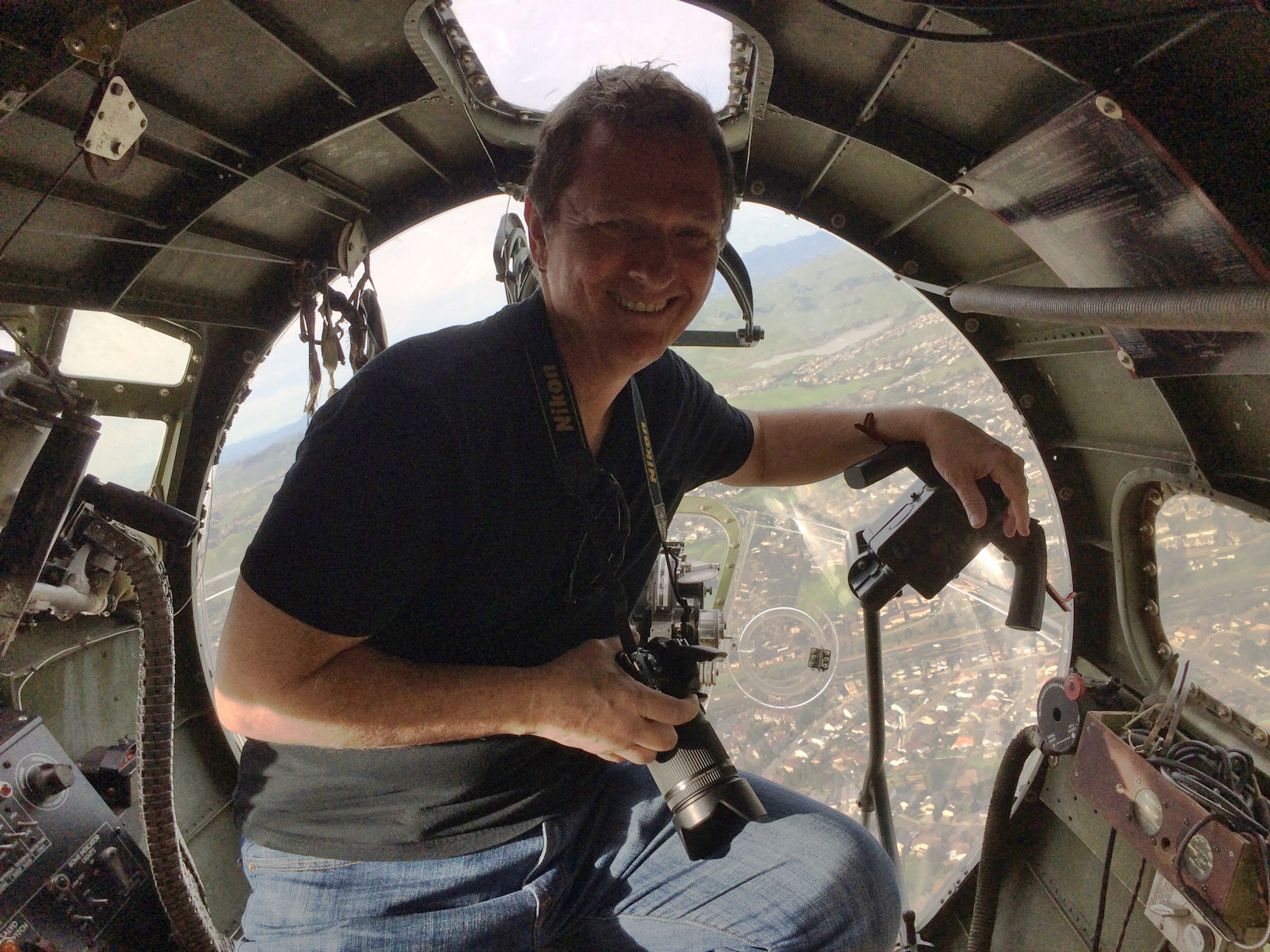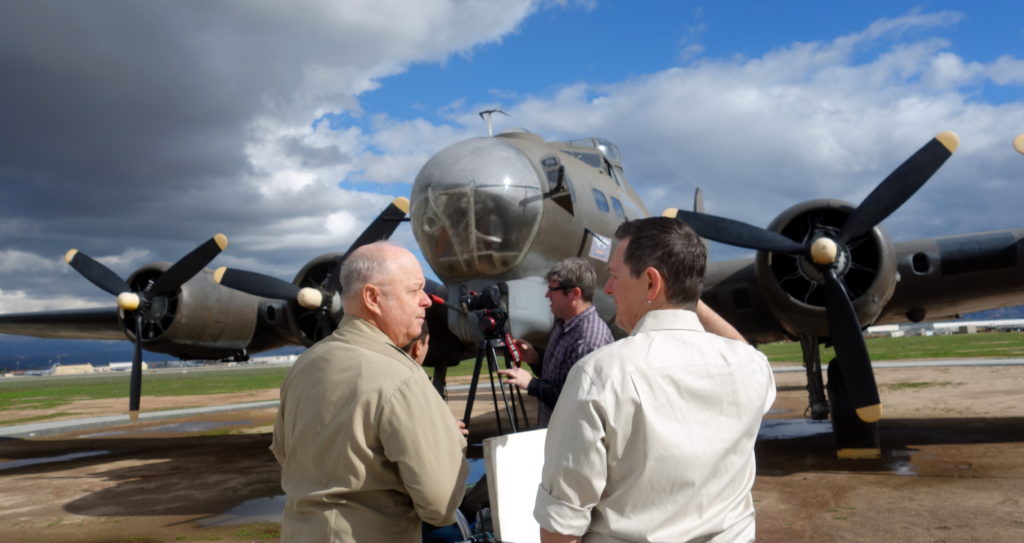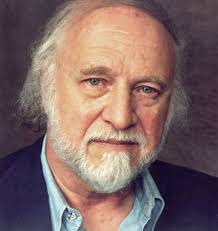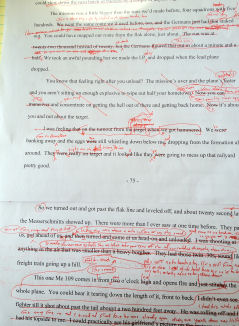
“The broken windows theory is a criminological theory that states that visible signs of crime, anti-social behavior, and civil disorder create an urban environment that encourages further crime and disorder, including serious crimes.”
Living in a favorite novel

I woke up this morning to the realization that I am now living in one of my favorite novels.
Unfortunately, the novel is Dhalgren.
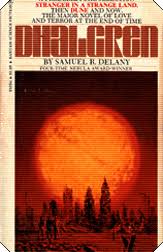
Silver Scream back in print
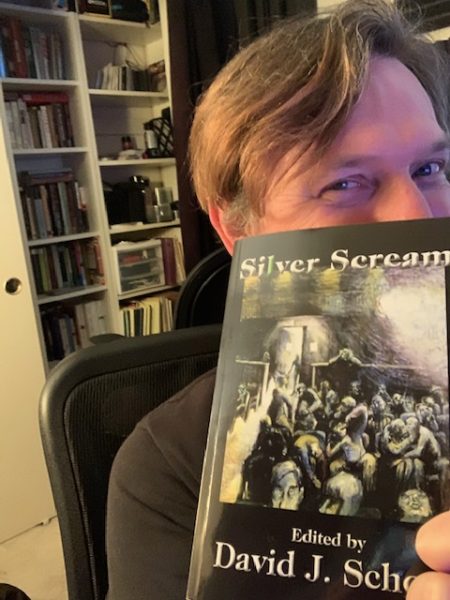 Dave Schow’s massive movie-industry-themed 1988 horror anthology Silver Scream has been reprinted by Cimarron Street Books. I have a story in it, so yay!
Dave Schow’s massive movie-industry-themed 1988 horror anthology Silver Scream has been reprinted by Cimarron Street Books. I have a story in it, so yay!
Dave is credited with inventing the word splatterpunk to describe a movement of younger writers in 80s horror that tended more toward the cinematic than the literary, more punk than progressive, more grindhouse than arthouse. Silver Scream made a splash–nominated for the World Fantasy Award, very favorably reviewed, a core-sampling of the 80s horror landscape, and containing some stories that became much-reprinted classics, such as Joe Lansdale’s “Night They Missed the Horror Show” and Robert McCammon’s “Night Calls the Green Falcon,” not to mention director Mick Garris’ first published short story, “A Life in the Cinema.” It’s generally considered to be one of the two definitive splatterpunk anthologies.
I hadn’t published much that would be considered any type of horror, much less splatterpunk, but I was friends with a whole bunch of horror writers, and I relished the opportunity to hang with them in books, too.
But I knew I couldn’t compete with them in terms of sheer goosh. They were scary and icky for a living. Luckily, I had worked as a word-processing operator (a Brand New Thing back then) for the University of Florida History and English departments, and I typed more academic exegeses than you can imagine. We’re talking books in 12th Century Merovingian Latin (hi, Dr. Geary!), Freudian analysie of horror archetypes as social behavior templates (hi, Dr. Twitchell!), post-structuralist grammatological examinations of lard-and-felt sculptures as illuminations of feminist criticism (you think I’m making this up, don’t you?).
So I was in a perfect position to write a horror story about academic film criticism. “The Answer Tree” is about a film critic at a rare screening of a legendary horror movie so subliminally seductive that it kills people. It’s a serious version of the Monty Python “killer joke” skit performed as a mashup of surrealist biography and iconography involving Cocteau, Bunuel, Dali, Lynch, and others. The challenge wasn’t to move the plot toward some Big Reveal about the movie killing someone, it was to chart the movie’s unfolding, supplemented with excerpts from fictitious academic works about the director, in a way that showed you how that process might happen.
“The Answer Tree” created an entirely fictitious film career and oeuvre that seemed genuine. I’m gauchely proud of it, and very glad it’s back in print.
I’ve been very lucky regarding anthologies. I haven’t published in many, but some of them have been considered influential, even landmarks. Silver Scream was one.
My novella “Like Pavlov’s Dogs” was included in the other definitive splatterpunk anthology, John Skipp & Craig Spector’s very loud, gooshy, popular, and influential 1989 Book of the Dead. It was the first zombie anthology, a shared-world anthology that takes place in George Romero’s zombie universe (with an an intro from Romero). It’s been credited with playing a role in the, um, rebirth of the modern zombie genre (unbelievably still, um, alive).
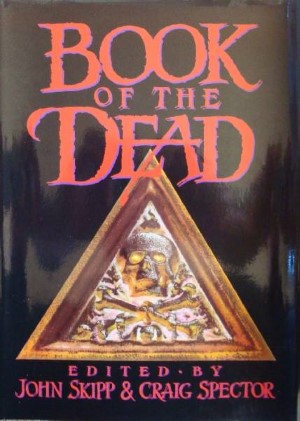
BotD was a cross-section of 80s horror writers, and I was delighted when John Skipp invited me to write something for it. Given the company I was keeping, I was thrilled when John told me he thought that the violence and death in “Pavlov” was very disturbing because it was so personal.
Though it was commercially and critically popular, BotD has a checkered history. Skipp and Specter’s agent sold its foreign rights and never paid anyone a dime, then made off with a not-insubstantial amount of royalties. Despite the book being something of a landmark, no one in it made a dime in royalties. I’ve never even seen one of the foreign editions. And Craig Spector tried to sell a reprint to White Wolf Press under another title without even notifying the contributors, much less paying us, which initiated some very colorful letters (this was before email) and threats of grievous bodily harm. I remain mystified why anyone chooses writing as a career. But I’m still delighted to have been a part of BotD.
My novella “Prodigy” was the lead story in Terri Windling’s 1986 Borderland anthology, which generally has been regarded as one of the originating examples of what became known as Urban Fantasy (though the perception of Urban Fantasy itself has changed a good bit over time).
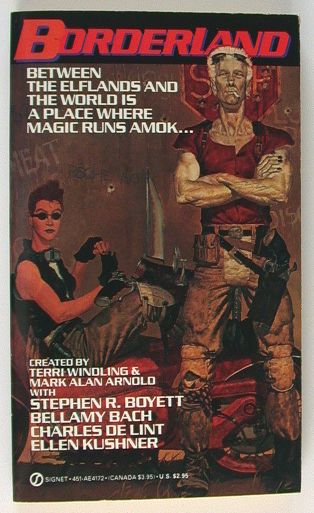
I have to admit that “Prodigy” is an odd fit in the anthology. I think Terri wanted Borderland to have a sort of Manhattan-meets-Faerie feel, and I set my story in a fantasy-postapocalyptic Los Angeles that seems to better fit the Change milieu of my novels Ariel and Elegy Beach (so much so that I allude to “Prodigy” in the next Change novel, Avalon Burning).
But I was flattered to be asked to contribute, and glad to be part something so often cited as making an impression on many young readers of fantasy.
Better Living Through Math
California governor Gavin Newsom warns that the state projects roughly 56% of its population will be infected with the COVID-19 virus over an 8 week period.
- California population = 39.5 million
- 56% of 39.5M = 22,120,000
- COVID-19 death rate = 2%
- 2% of 2,212,000 = 442,000
That’s 442,000 dead people as a result of infections incurred over the next two months. In California alone.
Anyone still saying this is no big deal, people are overreacting, it’s a liberal plot, not gonna change your behavior — go fuck yourselves.
And maybe pull out your smart phone and do that math with 330 million and 9 billion as the starting figures. (If you’re too lazy to figure it on your cell phone, which you could’ve done for months now, because these numbers have been there the whole time, it’s 3,696,000 and 100,800,000 dead.)
Now try to imagine the emotional, economic, and physical impact of that many dead bodies in that amount of time.
Or just keep insisting you’re right, and wait two months for someone to throw lime in a pit filled with your friends, your relatives, you.
What’s That Sound?

| Stop being surprised. | To be surprised by consistent and expected behavior is to be obtuse or in denial. Put yourself in their place and figure out where their beliefs are leading them. |
| Stop being offended. | Offense is the wrong response to being repeatedly and predictably pushed. Prevent the push. Resist the push. Push back. |
| Stop saying they should be ashamed. | They have no shame. |
| Stop asking how they can sleep at night. | Those without conscience sleep better than you do. |
| Stop saying that history will revile them. | History will be revised by them. |
| Stop saying voter turnout is the top priority. | Securing the vote is the top priority. |
| Stop waiting for someone to save you. | Comey was never going to save you. Mueller was never going to save you. Pelosi was never going to save you. Bolton was never going to save you. The intelligence agencies, the Steele dossier, the media, the press, Twitter, and Facebook were never going to save you. Impeachment was never going to save you. They aren’t worried about reelection, so it’s clear the election will not save you. Infrastructure is being stripped bare and will not save you. The courts are stacked and impeding rulings are being disregarded, so the law will not save you. Anger might save you — if it leads to action. Action when you need saving means saving yourself. Saving yourself means staying active to save others. |
| Stop acting like a boxer who will win by sticking to the rules. | Our opponent is no longer there to box. He’s there to get rid of us and own the ring, and rules impede him. He brought a chainsaw. Stop appealing to the referee. Our opponent hired this referee after he forced the ethical one out. And after we’re eliminated our opponent will crown himself Champ for Life. He’ll claim he has no rivals, and no one will ever see any because all potential challengers will be culled and gang-walked out behind the arena and shot in the head and buried in unmarked pits. |
| Stop saying the arc of the moral universe bends toward justice. | They don’t live in a moral universe. They are bending the arc to suit their ends. |
This is who you’re up against. The time for wishing they would act like you is past. The time to reason with minds beyond reason is not only past, it never existed.
It’s time to act — not act like victims. Act up, act out, act now.We think the sound of marching jackboots has receded into history. Our future hinges on our understanding that there was an even earlier time when that sound was not receding but approaching. When entire populations with our same faith in institutions and saviors and the triumph of moral right were trodden into ash and pits and slavery by the inundation of those boots. It’s the sound of history about to march across us, and denial has never silenced it.
The more things change….
I originally posted this when Trump was inaugurated. For the life of me I can’t figure out why it isn’t still up on my blog. But considering that events in Amerika make me think of this nearly every day, I’m making sure it’s up here. For me it remains more frightening than any horror-movie scene ever filmed.
Fight these motherfuckers.
Satan’s Honda
A brimstone milestone for my car: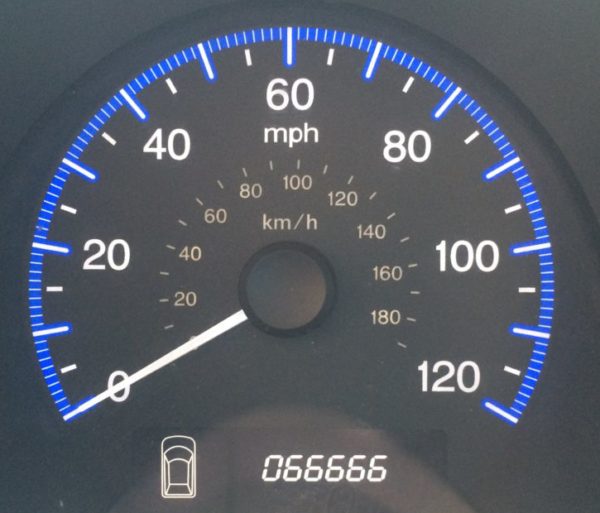
Signing & DJing @ Borderlands SF
Borderlands Books in San Francisco is having a huge 20th Anniversary celebration on Nov. 18. There’ll be a ton of writers autographing their books. I’ll be signing at 5:00 PM, along with Ken Mitchroney, my co-author on Fata Morgana.
At 4:00 PM I’be DJing the party (except for my signing slot, when I’ll be playing a recorded mix), then DJing the sponsor party afterward.
Borderlands has been a fantastic supporter of my work, and I had a blast DJing their party last year (the live mix, Funk by the Book, was released on Groovelectric), and I’m really looking forward to this year’s. If you’re around, stop by and say hi!
Borderlands Books
20th Anniversary Party
Saturday, Nov. 18, 2017
12:00 – 6:00 PM
866 Valencia Blvd., San Francisco, CA
Reviewer Reviews Reviews
The Amazon reviews for Fata Morgana have been fantastic — at this writing, a whopping 74% of them have given five stars, and 15% have given four, for an unbelievable 89% combined four- and five-star reviews: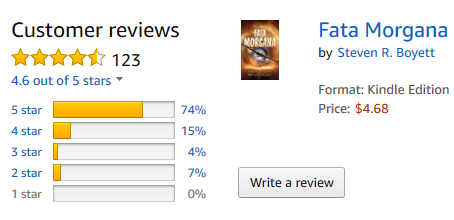
Apparently this proved too unbelievable for reviewer Bolivar S., who wrote: “Too many of these reviews sound like they were written by a copywriter. Four stars for getting to comment, won’t be purchasing the book.”

I’m very aware of the practice of paying for fake Amazon reviews, especially among indie & self pub authors. They’re usually pretty easy to spot (short, generic, lacking details specific to the book), which is all the more reason I am flattered by the Bolivar S’s implication that these reviews are so good they must be fake.
Leaving aside the brain-hurtingly recursive fact that Bolivar S is giving four stars to a book he hasn’t read while suggesting that we shouldn’t trust its high-level reviews, I can only make things even more meta by saying that this has now become my all-time favorite Amazon review of Fata Morgana! ★★★★★
Burning Man 2017
The thing I like best about Burning Man is simply the fact that it exists.
I had some fantastic experiences on the Playa this year. I worked as a Greeter one day. I saw some truly amazing art and met some fascinating people. I also Tetrised most of our camp into a shipping container after the event. (It’s this weird ability I have. I even optimize dishes for the dishwasher. A bit OCD, but useful.)
That said, I’m going to have to do a lot of thinking about going back. I’m not sure what Burning Man has for me anymore, and especially vice versa.
There’s video below the gallery.
The articulated bird installation, with passing art car:
[jwplayer config=”Custom Player” mediaid=”4350″]
The LED Tree. This was simply beautiful:
[jwplayer config=”Custom Player” mediaid=”4351″]
This was a mirrored, planed skull about 12 feet high. I could have watched it for an hour:
[jwplayer config=”Custom Player” mediaid=”4352″]
Happy Bloomsday!
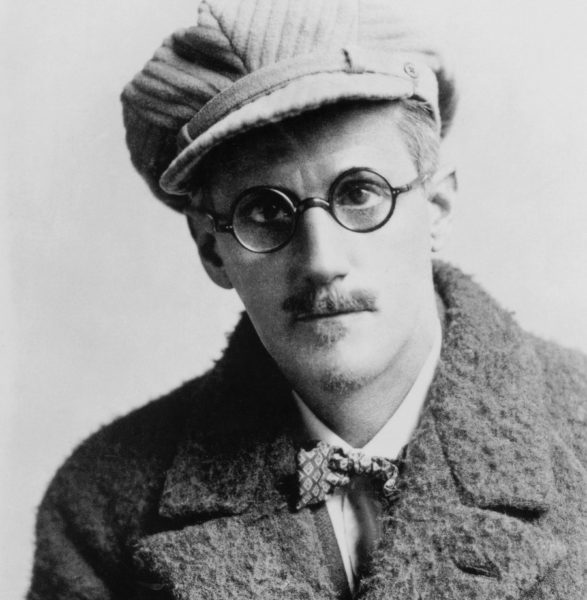
The events of Joyce’s epic and wonderful Ulysses all take place in Dublin on June 16, 1904 — Bloomsday, named for one of the protagonists, Leopold Bloom.
Raise a pint to James Joyce, and celebrate the man who gave us the mythic in the mundane, the epic in the ordinary, and the eidetic re-creation of the world in the printed word.
I saw he understood or felt what a woman is and I knew I could always get round him and I gave him all the pleasure I could leading him on till he asked me to say yes and I wouldnt answer first only looked out over the sea and the sky I was thinking of so many things he didnt know of Mulvey and Mr Stanhope and Hester and father and old captain Groves and the sailors playing all birds fly and I say stoop and washing up dishes they called it on the pier and the sentry in front of the governors house with the thing round his white helmet poor devil half roasted and the Spanish girls laughing in their shawls and their tall combs and the auctions in the morning the Greeks and the jews and the Arabs and the devil knows who else from all the ends of Europe and Duke street and the fowl market all clucking outside Larby Sharons and the poor donkeys slipping half asleep and the vague fellows in the cloaks asleep in the shade on the steps and the big wheels of the carts of the bulls and the old castle thousands of years old yes and those handsome Moors all in white and turbans like kings asking you to sit down in their little bit of a shop and Ronda with the old windows of the posadas 2 glancing eyes a lattice hid for her lover to kiss the iron and the wineshops half open at night and the castanets and the night we missed the boat at Algeciras the watchman going about serene with his lamp and O that awful deepdown torrent O and the sea the sea crimson sometimes like fire and the glorious sunsets and the figtrees in the Alameda gardens yes and all the queer little streets and the pink and blue and yellow houses and the rosegardens and the jessamine and geraniums and cactuses and Gibraltar as a girl where I was a Flower of the mountain yes when I put the rose in my hair like the Andalusian girls used or shall I wear a red yes and how he kissed me under the Moorish wall and I thought well as well him as another and then I asked him with my eyes to ask again yes and then he asked me would I yes to say yes my mountain flower and first I put my arms around him yes and drew him down to me so he could feel my breasts all perfume yes and his heart was going like mad and yes I said yes I will Yes.
Release Day!
Fata Morgana is officially released today!
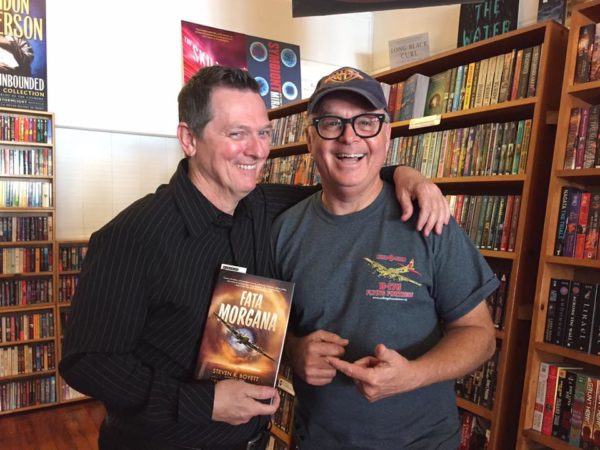
This last weekend Ken & I read & signed at Borderlands Bookstore and at SF in SF. I recorded the readings & will post as soon as I can. Right now I’m scrambling to get a Podrunner mix out and get ready to go down to Los Angeles for our series of SoCal signings.
Meantime, here’s some pix from the Borderlands event last Saturday. Our heartfelt thanks to Alan Beatts, Jude Feldman, and the truly wonderful crew at Borderlands Books & Cafe for a great launch.
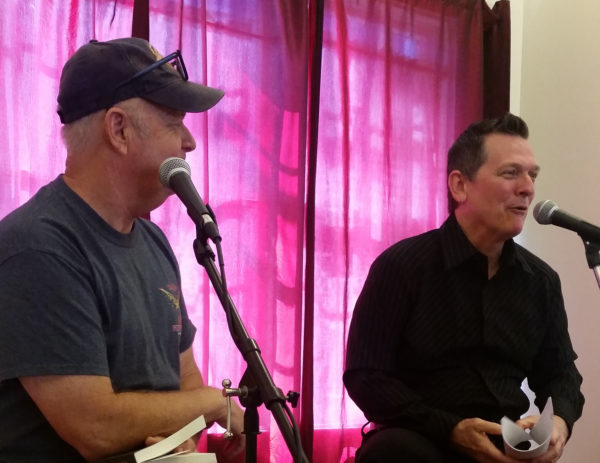
Ken has done a ton of signings — he used to draw Ninja Turtles, fer cryin’ in the sink — but this is his first book signing, and he was like a puppy. After our reading and Q&A, we started signing books. I was writing my name when I heard Ken beside me say, “Hey — this is the first book we’ve signed for someone!” (Hello, Uffe in Switzerland, who was awesome enough to special-order our novel!)
We stopped and gave each other a huge hug.
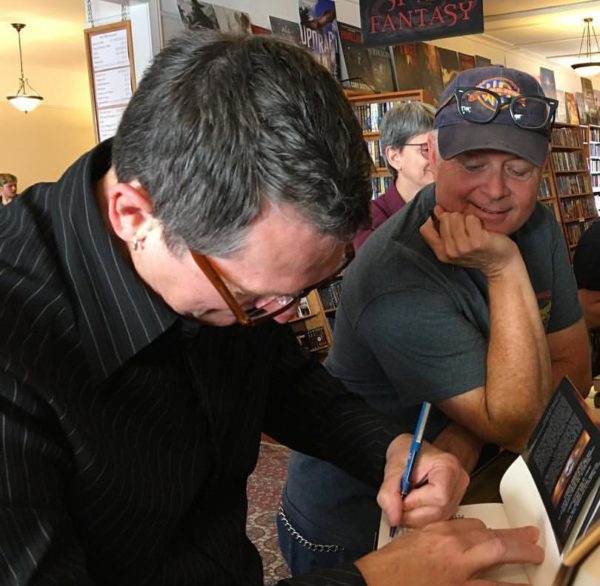
David Gerrold, Dr. Seuss, and I
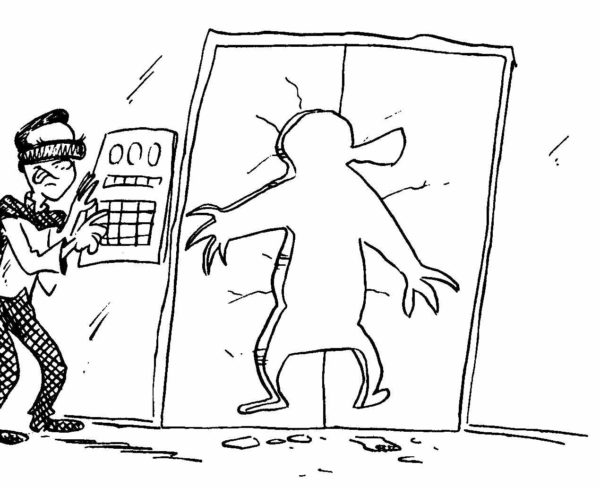 ComicMix just won a legal battle against the Dr. Seuss estate over the right to conduct a Kickstarter campaign trying to raise upwards of $20,000 for an illustrated book written by David Gerrold called Oh the Places You’ll Boldly Go! that mashes up Seuss and Star Trek.
ComicMix just won a legal battle against the Dr. Seuss estate over the right to conduct a Kickstarter campaign trying to raise upwards of $20,000 for an illustrated book written by David Gerrold called Oh the Places You’ll Boldly Go! that mashes up Seuss and Star Trek.
Here’s my problem with this.
I rented a room from David Gerrold when I moved to LA (David was instrumental in getting me there from Florida, for which I am eternally grateful). In 1996 I published a collection of ST:TNG parodies called Treks Not Taken. It contained a mashup of Trek & Seuss called “Oh, The Treks You’ll Take!” with illustrations by Ken Mitchroney.
I gave David a copy when it was published in its small-press edition (it was later picked up by Harper Collins).
So when I read that David — who has already published a Trek pitch of mine as a Star Wolf novel (The Middle of Nowhere) without my express permission — is somehow being lauded as a creative artist emerging victorious after being put down by the Man, I can only shake my head in wonder.
As The Man Who Shot Liberty Valance bemoans, “When the legend becomes fact — print the legend.”
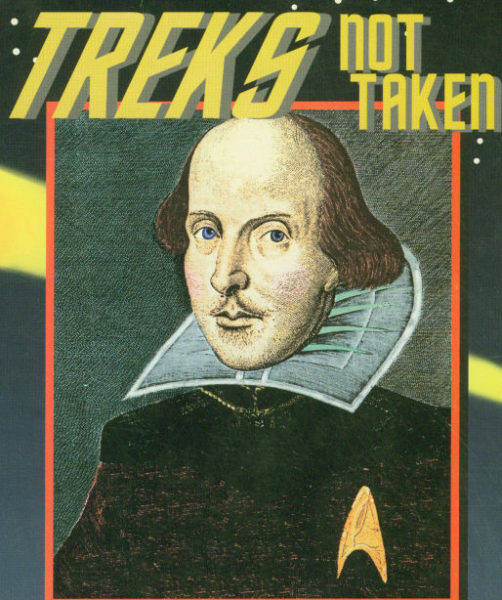
Ken Mitchroney: Have a Cigar!
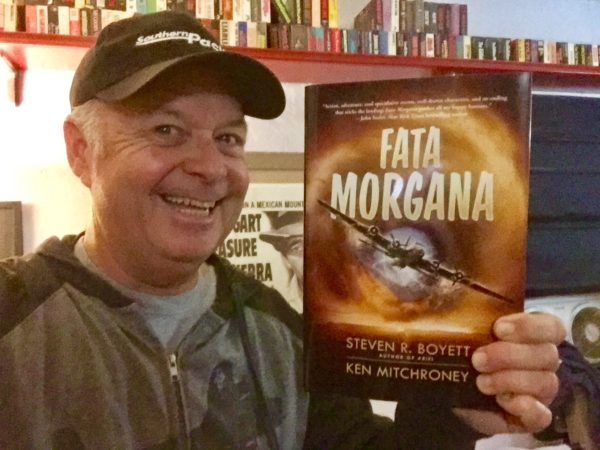
Ken Mitchroney and I have been friends for well over 30 years. We’ve worked on a lot of projects together — comic books, animated shorts, screenplays, feature films. We’ve created catalog copy and bubblegum cards together. Hell, I once made a didgeridoo that Ken pinstriped and Ed “Big Daddy” Roth auctioned.
These are gigs that came Ken’s way that he included me on. Even the original screenplays we’ve done have tended to be in areas I wouldn’t have ventured (baseball, NASCAR racing) without Ken’s involvement. Until I began to DJ and podcast, my work had always been fiction — pretty much a solo endeavor, and not easy to involve Ken with.
Which is why, all these many years later, it’s a source of great joy to me to see Ken — who has drawn, managed, directed, or supervised for Disney, Pixar, Dreamworks, Spielberg, Marvel, Archie, Cartoon Network, and tons more places — light up like a kid at a Christmas tree when he got his author copies of the published hardcover of Fata Morgana, our first novel together.
However much you envision that finished book — and we had an amazing amount of input on the look & feel of the final product, thanks to the amazingly collaborative approach of our publisher, Blackstone — nothing prepares you for finally holding the thing in your hands. Ken was babbling when he got it.
So, congratulations to my friend Ken. Here’s to another first in our friendship and long collaboration. Cheers, mate!
FATA MORGANA Signings & Readings
 Fata Morgana will be out in a few weeks, and Ken Mitchroney & I will be doing signings & readings in San Francisco, Los Angeles, and San Diego in the coming month.
Fata Morgana will be out in a few weeks, and Ken Mitchroney & I will be doing signings & readings in San Francisco, Los Angeles, and San Diego in the coming month.
We’ll probably add some events, but here’s our schedule so far:
June 10, 2017
SAN FRANCISCO, CA
Borderlands Books
3:00 PM (map)
The official Fata Morgana Launch Party! Reading, signing, interview, and atrocious jokes galore.
June 11, 2017
SAN FRANCISCO, CA
SF in SF
Reading, interview by Terri Bisson. A wonderful series at a great venue.
American Bookbinders Museum
6:30 PM (map)
June 15, 2017
BURBANK, CA
Burbank Library Buena Vista Branch
Reading, signing, discussion
7:00 PM (map)
June 17, 2017
SAN DIEGO, CA
Mysterious Galaxy Bookstore
Signing & discussion
2:00 PM (map)
June 18, 2017
BURBANK, CA
Dark Delicacies Bookstore
Signing
4:00 PM (map)
July 20-23, 2017
SAN DIEGO, CA
San Diego Comic Con
Signing
THURSDAY: 10:00 AM – 2:30 PM
FRIDAY: 10:00 AM – 2:30 PM
SATURDAY: 2:30 PM – 7:00 PM
Location TBA
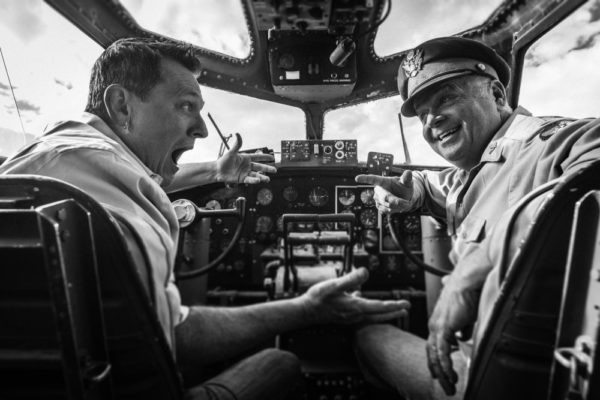
Borderlands Bookstore window
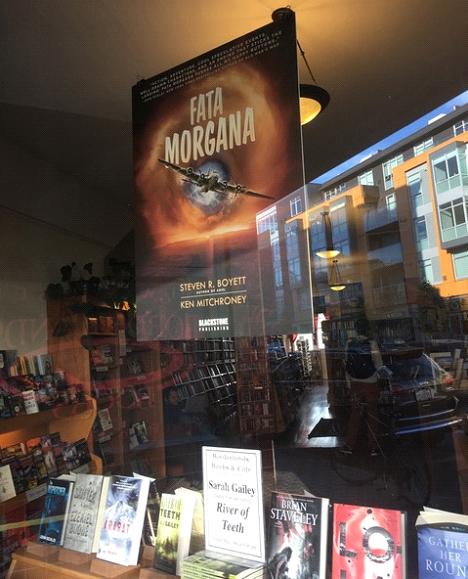
The wonderful folks at Borderlands Bookstore in San Francisco put the very nice poster for Fata Morgana in their front window, looking out on Valencia Street. Thank you, guys!
If you’re in San Francisco and read fantasy, science fiction, or horror, I can’t recommend Borderlands enough. The store itself is pleasant and well-stocked; the adjoining Borderlands Cafe serves outstanding coffee and pastries; staff is amazingly nice, helpful, and knowledgeable; and owner Alan Beatts is one of the most considerate hosts I’ve ever met. (Seriously. He makes me think I was raised wrong, or something.)
Even cooler (well, to me), Borderlands is hosting the Fata Morgana Launch party on June 10 at 3:00 PM. That’s a full three days before the official release date, so you can get your book — and get it signed by me & my co-author, Ken Mitchroney — before any other bookstore even has it for sale.
So come on down — I’d love to see you!
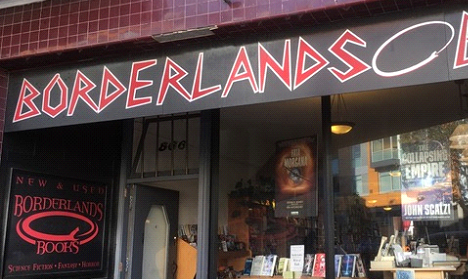
Goodreads FATA MORGANA Giveaway!
 Goodreads is giving away 10 Advance Reader Copies (ARCs) of Fata Morgana, my upcoming novel with Ken Mitchroney.
Goodreads is giving away 10 Advance Reader Copies (ARCs) of Fata Morgana, my upcoming novel with Ken Mitchroney.
The giveaway ends May 15, so hurry!
Goodreads Fata Morgana giveaway
[ujicountdown id=”Write Now theme” expire=”2017/05/15 23:59″ hide=”true” url=”” subscr=”Goodreads Fata Morgana giveawa” recurring=”” rectype=”second” repeats=””]
Name Your Price for ARIEL + 3 Novels – One Week Left!
[ujicountdown id=”Write Now theme” expire=”2017/05/03 11:00″ hide=”true” url=”” subscr=”humble bundle” recurring=”” rectype=”second” repeats=””]
I’m delighted that my first novel, Ariel, has been included in a unicorn-themed Humble Bundle curated by Peter S. Beagle, author of the classic The Last Unicorn.
Humble Bundle’s innovative, DRM-free ebook bundles let you name your own price and choose how your money is allocated. As little as $1.00 gets you Ariel; Unicorn Mountain, by Michael Bishop; Homeward Bound, by Bruce Coville; and Unicorn Triangle, by Patricia McKillip.
For $8.00 you get five more books, and $15.00 gets you five more. That’s 14 books for as little as $15.
Proceeds will benefit the World Wide Fund for Nature and Fauna & Flora International., so you can elect to pay more than the minimum prices and still get a fantastic deal while knowing that your money is going to a good cause.
The offer ends Wednesday, May 3, so don’t delay!
Fata Morgana – Sample Audiobook Chapters
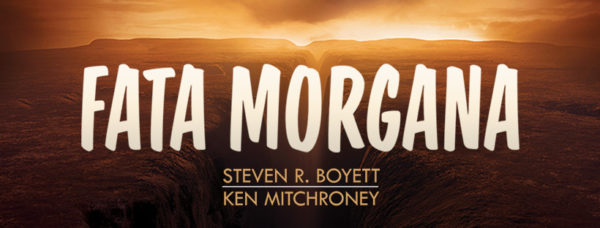 For those who like to hear their books, below are the Prologue and first two chapters of the Fata Morgana audiobook, which will be released on June 13, same time as the hardcover & e-book.
For those who like to hear their books, below are the Prologue and first two chapters of the Fata Morgana audiobook, which will be released on June 13, same time as the hardcover & e-book.
Hugely talented, award-winning, and unfairly good-looking actor MacLeod Andrews does the narration (my account of our visit to the recording session at the truly wonderful Deyan Audio is here, and the audio was already listed among Library Journal‘s Notable Releases for June. Yay, Library Journal!
Prologue:[jwplayer player=”2″ mediaid=”3998″]download
Chapter One:[jwplayer player=”2″ mediaid=”4001″]download
Chapter Two:[jwplayer player=”2″ mediaid=”3999″]download
Name Your Price for ARIEL Humble Bundle
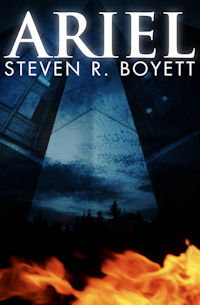 The e-book version of my first novel, Ariel, is available on a unicorn-themed Humble Bundle! Proceeds will benefit the World Wide Fund for Nature and Fauna & Flora International
The e-book version of my first novel, Ariel, is available on a unicorn-themed Humble Bundle! Proceeds will benefit the World Wide Fund for Nature and Fauna & Flora International
Humble Bundle is an innovative, DRM-free bundle of ebooks you can buy by naming your own price — and you can choose how your money is allocated.
For as little as $1.00, you can get Ariel; Unicorn Mountain, by Michael Bishop; Homeward Bound, by Bruce Coville; and Unicorn Triangle, by Patricia McKillip.
$8.00 gets you five more books. $15.00 gets you five more than that — 14 books for as little as $15. You can elect to pay more than that and still get a fantastic deal while knowing that your money is going to a good cause.
The Humble Bundle offer ends Wednesday, May 3.

I Buzzed My Neighborhood in a B-17
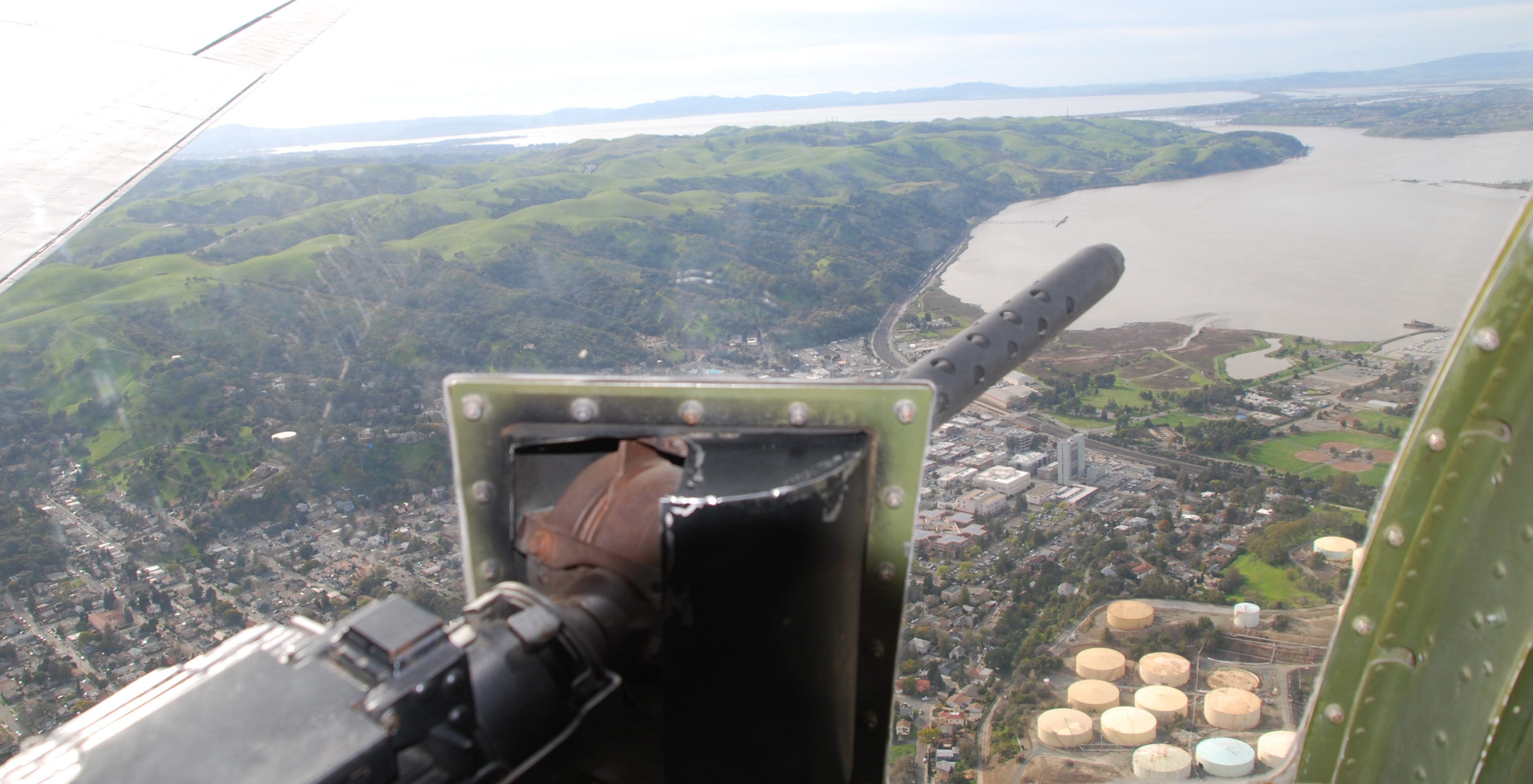 Sometimes my luck is just ridiculous.
Sometimes my luck is just ridiculous.
Last week my friend (and Fata Morgana co-author) Ken Mitchroney mentioned that his wife, Beth, the Last of the Old School Reporters, would be taking a media flight on a visiting B-17G bomber, the Aluminum Overcast. There are literally only 12 of these still flying, and opportunities to go gallivanting in one aren’t hugely common. Especially for free, and especially for writers who have a novel about one coming out in three months.
So I was totally joking, only I wasn’t, but I was, really (not), when I said, “Well, heck, Beth’s gonna need a photographer, then, won’t she?”
“I’ll call you back,” Ken said.
An hour and a couple of email exchanges later: “Okay, you’re in. You’ll be taking shots for Beth’s story.”
Next day I tightened my vintage military seatbelt and felt the runway drop away as the Aluminum Overcast took to the air and flew along the Carquinez Strait — where I live. I shot pix like a madman and headed straight for the bombardier station in the nose. A camera operator from Channel 2 news took this shot with my phone. My house isn’t in the background — but it’s close.
The weirdest thing about my bomber flight was how familiar it felt.
I have been living, breathing, eating, and dreaming B-17F bombers and World War II for four friggin years. History books, self-published crew accounts, pilot & belly gunner manuals; period documentaries, newsreels, and movies; photographs; talks with vets; endless talks and notes and sketches with Ken — everything I could do to make you feel as if you really are on board the B-17F Flying Fortress Fata Morgana along with ten brave scared wisecracking guys for their epic little mission into the unknown.
So even as my heart was pounding and I was thinking omigodthisisthecoolestthing ever, part of the thrill I felt was a sense of vindication. Holy shit, I got it right.
Well, there was one thing.
Those bombers were as analog as it gets. The control cables for the rudder and ailerons run along the fuselage, right by your head. When the bomber hits turbulence, your reflex is to grab the wires to hold yourself steady. Don’t do that. The pilot needs those for things like turning and going higher and lower.
I wish I’d known about that reflex when the book was being written. It’s just one of those you-are-there details.
This adventure also marked my first-ever newspaper photo credit. Thank you, Ken! Thank you, Beth! Thank you, Experimental Aircraft Association and crew of the Aluminum Overcast!
A gentle reminder
“No snowflake in an avalanche ever feels responsible.”
—Stanislaw Jerz
Fata Morgana – Sample Chapters
Here’s the Prologue & Chapter 1 of Fata Morgana, my new novel with Ken Mitchroney coming out in June.
Reposting hugely appreciated!
Publisher’s Weekly just gave us our first “official” review, saying:
The prose is energetic, combining some of the gentler wit of Catch-22 with riffs on dystopian fiction clichés. Boyett and Mitchroney elevate the pulpy vibe with unusual and fully developed protagonists.
…which, um, okay.
Fata Morgana sample chapters & book giveaway coming soon!
Just a quick post to let you know that next week, sample chapters from Fata Morgana will be available for download in all major e-book reader formats and PDF.
Soon after that, Ken and I will be giving away Advance Reader Copies (ARCs) of the novel. Stay tuned!
Happy President’s Day!
Plus ça Change….
“Twenty-three years after the coming of Timoleon [338 BC] a rich man’s revolution suppressed the Syracusan democracy, and put the government into the hands of six hundred oligarchic families. These divided into factions, and were in turn overthrown by a radical revolution in which four thousand persons were killed and six thousand of the well to do were sent into banishment. Agathocles won dictatorship by promising a cancellation of debts and a redistribution of the land. So, periodically, the concentration of wealth becomes extreme, and gets righted by taxation or by revolution.”
—Will Durant, THE STORY OF CIVILIZATION:
The Life of Greece (1939)
Photo Bombers

Probably because he knows everyone and is interested in everything, Ken Mitchroney somehow arranged for us to have a photo session for our Fata Morgana author pic at March Field Air Museum on a B-17G bomber.
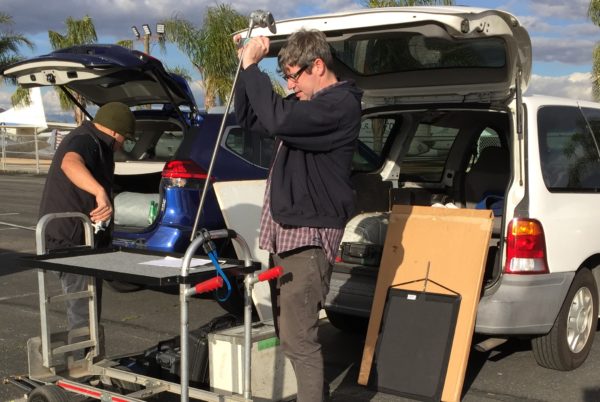
Jon Tucker, a hugely talented cinematographer who has worked with Ken, offered to take the shots. He showed up with an SUV full of gear and a cart, an assistant named Danny Sandoval — oh, yeah, and a camera.
The rain in LA had been unprecedented the previous few days, but the day of the shoot was gorgeous: Robins-egg-blue sky, massive clouds, and buckets o’ sunshine. Our luck was crazy.
Ken wanted to try to re-create this shot from the movie Air Force:
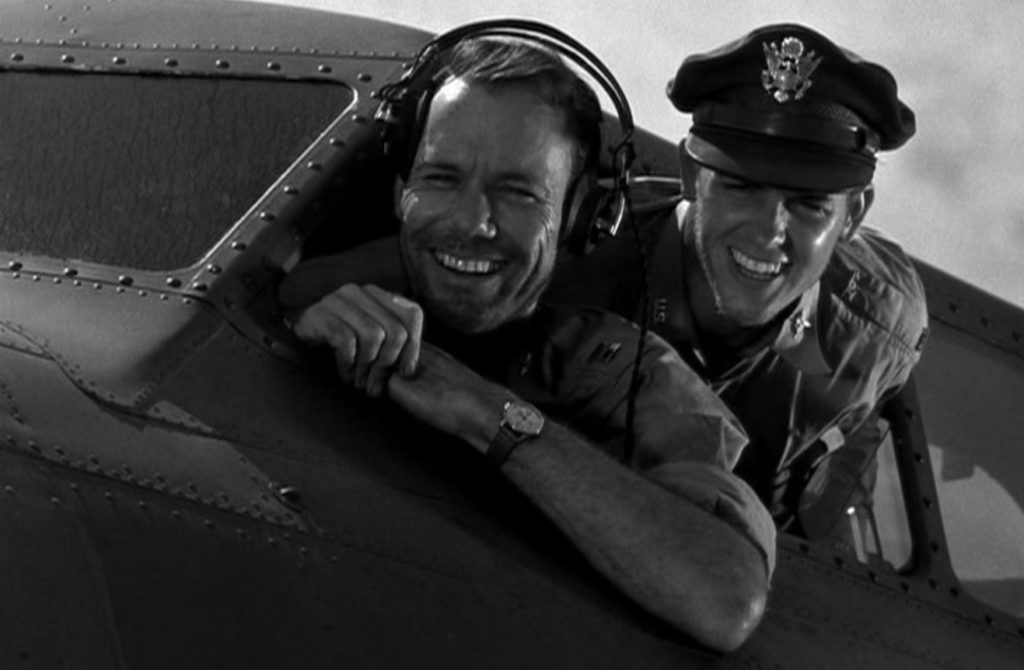
I thought it would look great, but it immediately became clear that we couldn’t do it, because the cockpit windows didn’t go back far enough. Either they were different in the earlier B-17, or they’d been rigged in Air Force. There was no way two of us could lean out of one window. Time to improvise!
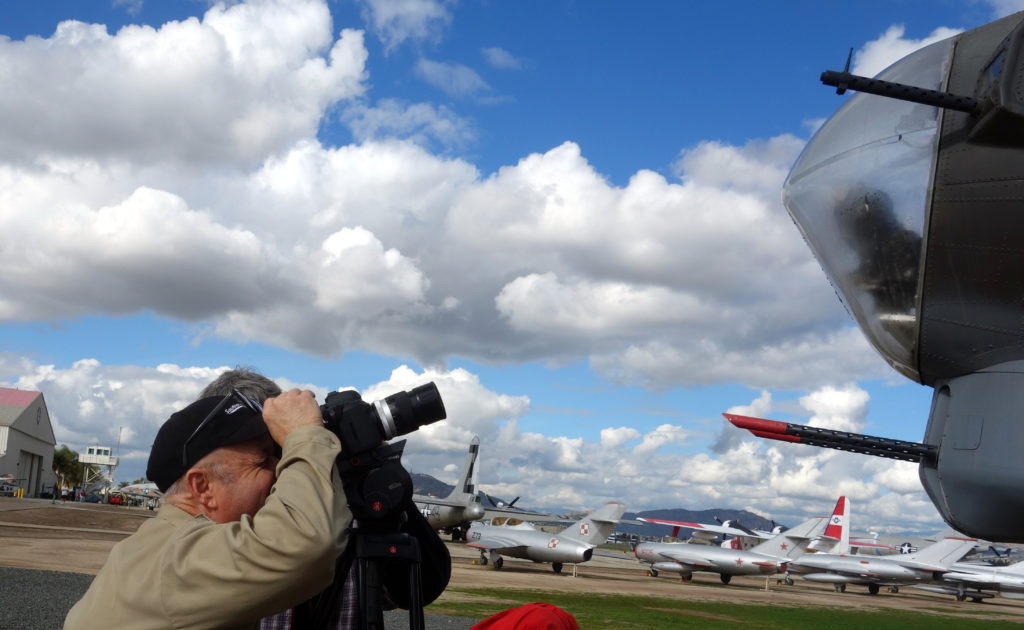
Ken worked with Jon on angles while my friend Scott Kelley shot “B-roll” of the activities. We took advantage of the opportunity to crawl all over that aircraft.
I’d thought that a shot looking through the windshield at Ken and I at the controls might be great. But the parked bomber angled up steeply, and Jon would have to be 15 feet up to get the shot. “No problem,” said March Field’s Greg Kuster. “We’ll get a scissor lift.”
Good lord.
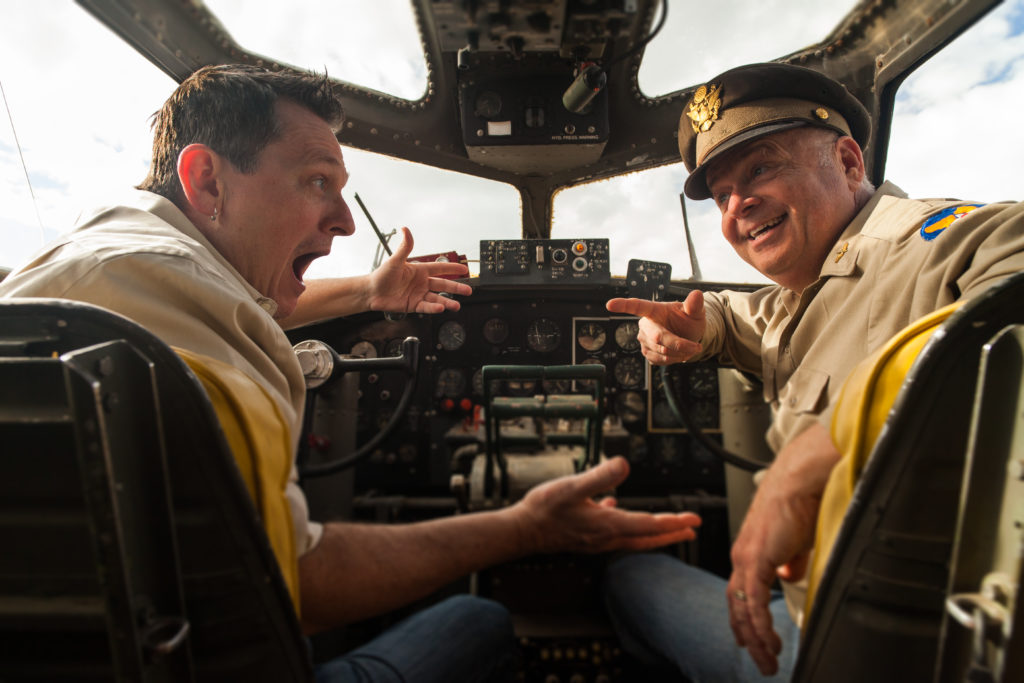
While they were bringing over the lift, Jon took shots of us in the cockpit. I thought this setup was ideal for an author shot, but we were completely backlit, and I scouldn’t imagine Jon would be able to get good lighting. Which maybe shows my limited understanding of exactly what a cinematographer can do, given the shots he ended up with.
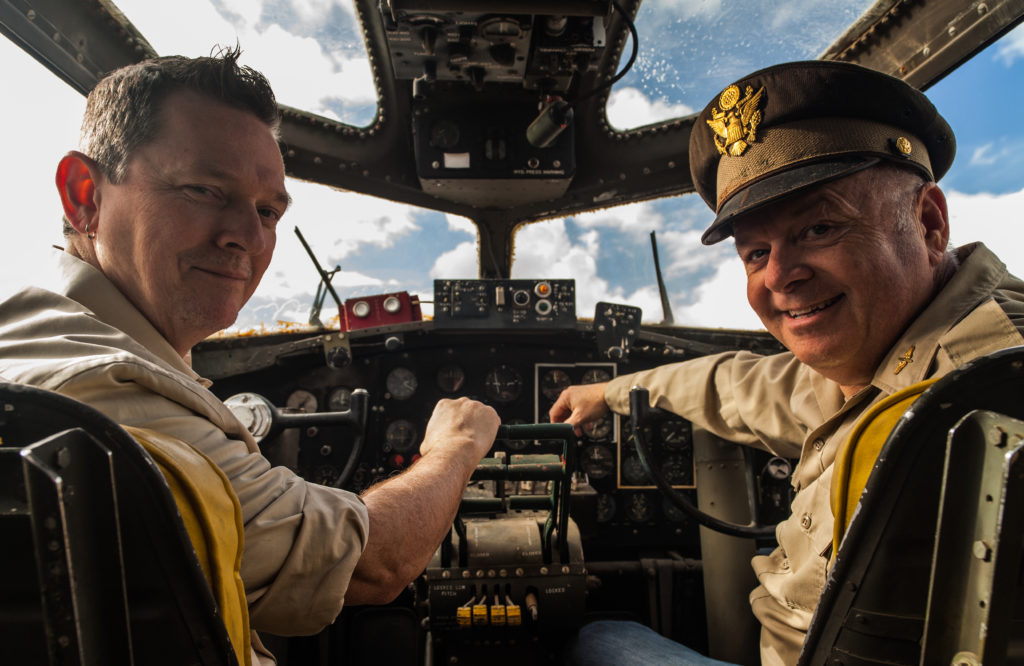
When Jon got raised up in the scissor lift, it was immediately clear that the through-the-windshield shot was out: The windshield was dirty, wet from the rain, and glaring in the relentless SoCal sunshine. So we stuck ourselves out the pilot & copilot windows instead, and Jon just beamed and yelled Ohh, yeah. Ken and I couldn’t stop grinning like idiots.

For my part, I’d been living in a B-17 in my head for the better part of four years working on this book. I’d done ridiculous amounts of research, watched videos, walked through the 909 and the Aluminum Overcast when they barnstormed Concord and Livermore. But it’s a completely different deal to have full, unsupervised access to a WWII bomber, to have no one else on board, to have no sense that you should hurry up and give someone else a look, and to go into places nobody but nobody gets to go. The cockpit, ferchrissake.
When Ken and I looked at each other across the top of the bomber and started laughing our asses off, I think we knew that this was gonna be the shot. When we got the pix from Jon, there was no doubting it.
We went for black & white because of the feel of the novel. I dunno what Jon did, but he made the damn thing look as if it’d been taken in 1943. Needless to say, Ken and I are stoopidly happy with our Author Shot, and can’t wait to see it on the jacket of the hardcover when it’s published in June.
Massive thanks to Jon Tucker and Danny Sandoval; to Scott Kelley for tons of behind-the-scenes shots; and to Greg Kuster and Paul Hammond of the March Field Air Museum, for their amazing help and kindness, and for opening up the Starduster to us. I highly recommend a visit to the Museum in Riverside, CA (I haven’t even talked about their spectacular collection). Our day there was literally one for the books.
Another Great Day at Deyan Audio

Two weeks ago Ken Mitchroney and I drove out to Deyan Audio in Tarzana to meet with MacLeod Andrews, who narrates the upcoming Fata Morgana audiobook. I’d been to Deyan previously, for the Ariel and Elegy Beach audiobooks, which I blogged about here. Suffice to say the staff and facility are made of pure awesome.
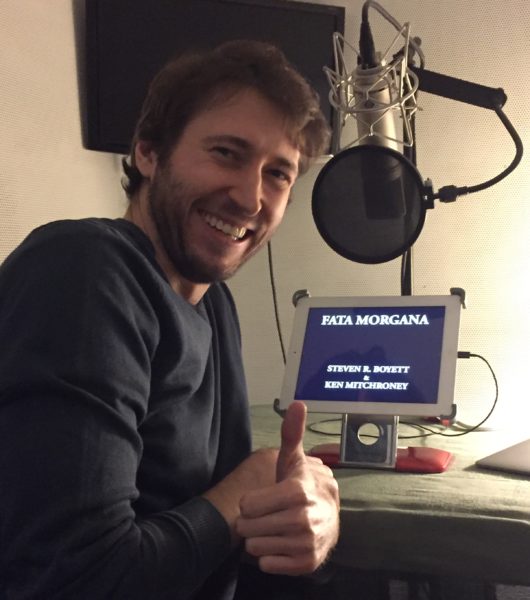
MacLeod is a hugely talented, ridiculously handsome, up-and-coming actor who has narrated a ton of books and won several awards. Ken and I picked him instantly after hearing his audition; his reading was perfect.
The audiobook’s producer, Bryan Barney, was great about working with us to solve some problems in translation from print to audio. (For example, Chapters 4, 5, & 6 end and resume in midsentence to indicate an abrupt transition from one place to another, which wouldn’t work for an audiobook because [a] the narrator announces the new chapter, which would ruin the effect, and [b] the mp3 version would contain separate chapter files that would stop and start midsentence, likely making a listener think something had screwed up. The solution: combining those chapters into one. Ta-da.)

I’m in the midst of sound-treating my office/studio with a view to record an audiobook of Mortality Bridge, so for me the recording rooms at Deyan are pure sound-engineer porn: Efficient, acoustically flat, with vocal booths bought from an audiologist and repurposed for recording (genius!). And Genelec monitors — ka-ching!
Ken and I joked around a lot, and sat in on the beginning of the session, but we cleared out soon afterward. We didn’t want to loom, and it was pretty obvious the production was in good hands.
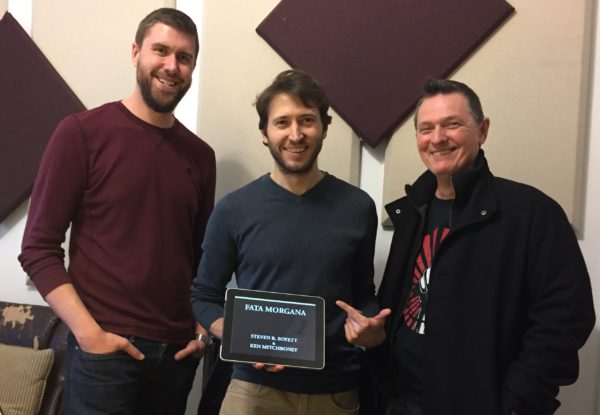 I have to say, I’ve been pretty lucky. It’s not that common for writers to meet with the narrators of their books or show up for the recording session.
I have to say, I’ve been pretty lucky. It’s not that common for writers to meet with the narrators of their books or show up for the recording session.
Even luckier, I’m getting a shot at composing the audiobook’s theme music. Maybe it’ll sound like chickens in a blender, but it’s an opportunity I can’t pass up. I’ll blog about that & post the audio file when it’s done, probably in a couple of months.
Tune in next time for the truly awesome production that was our Author Shot in a B-17 bomber!
Bookwork in L.A.
I turned in the proofread galleys for Fata Morgana to Blackstone this week. Other than reviewing the corrected proof and final cover jacket, there’s little production work left until June. Woo hoo!
Next week I’ll be in Los Angeles, which I’m excited about for three reasons:
1. March Field Air Museum has generously allowed Ken & I the use of their B-17G, Starduster, for our author shoot! How awesome is that? Big moby awesome. Definitely looking forward to this!
2. They’re recording the Fata Morgana audiobook at Deyan Audio in Tarzana. Deyan is where the Ariel and Elegy Beach audiobooks were recorded (I posted about My Day at Deyan Audio back then), and Bob and Deb Deyan became good friends. I was devastated when Bob died of ALS two years ago. He was an amazing, generous, and just plain fun guy, and my friendship with him was just getting off the ground when I moved from LA to the SF Bay area. He is hugely missed by a great many people.
Deb will be out of town while we’re there, dammit, but Ken & I will get to meet the narrator, actor MacLeod Andrews, along with the production team. The opportunity to do that is priceless.
3. I haven’t been to LA in nearly five years. That freaks me out a little. I lived there for 30 years, and loved the hell out of it, until I didn’t any more. I never would have imagined I’d go five years without a visit. I won’t have a lot of time to hit all my favorite spots, but I plan to try.
Christmas Comes Early!
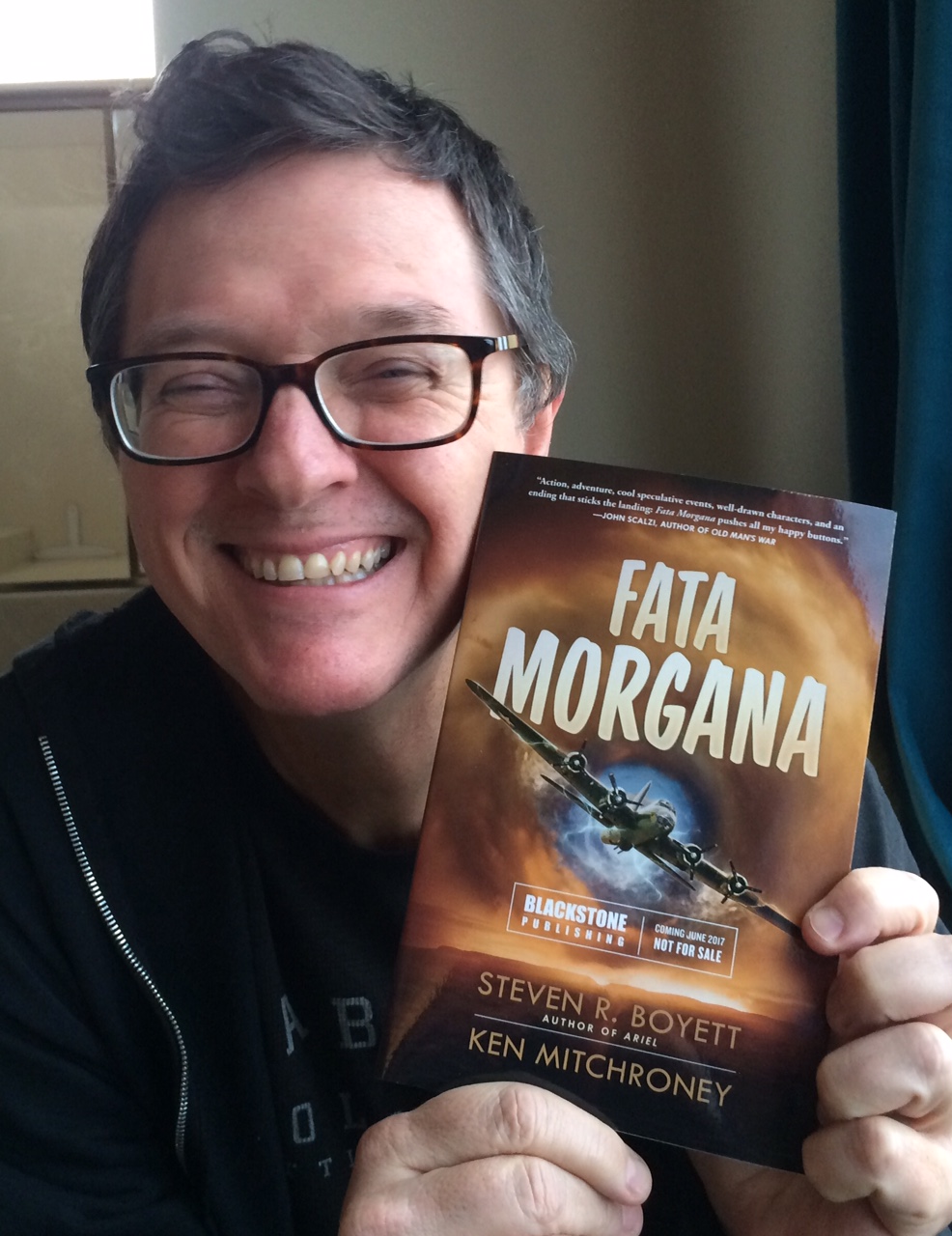
You spend years writing & revising a book. You go through all kinds of anxiety marketing it. You sell it, you work with the publisher on all kinds of aspects. Gradually the idea of it, the abstraction of words, becomes imagined as an object: The embodiment of words.
Yet however many times you go through that process, nothing prepares you for the moment you hold the thing itself. Some superstitious monkey part of your brain thinks, I have thought a thought inside my head and now it is a thing out in the world.
In my case, that thing — the Advance Readers Copy — had been delayed by snow for days, and when UPS rang the doorbell this morning I ran down the stairs like a kid tearing for the Christmas tree. (Which also explains why I look as if I just got up. I don’t know how to explain how I look the rest of the time.)
And as much as Ken and I have worked to make this book real, and as much input and collaboration as we have had with our publisher, Blackstone, to realize this idea, I still think it looks unbelievably better than how I thought it would look. And I thought it was gonna look pretty good!
Fata Morgana is Ken’s first novel — he’s over the moon right now!
And the hardcover pre-order is being discounted at $19.56 at Amazon. Get thee hence, I say!
Fata Morgana Cover!
Fata Morgana, my collaborative novel with Ken Mitchroney, will be out from Blackstone next June 13 in hardcover, ebook, and audiobook. Ken and I worked closely with Kathryn English, Blackstone’s lead designer, on the book’s cover, and we’re really happy with it. Click the pic for full-sized awesomeness.
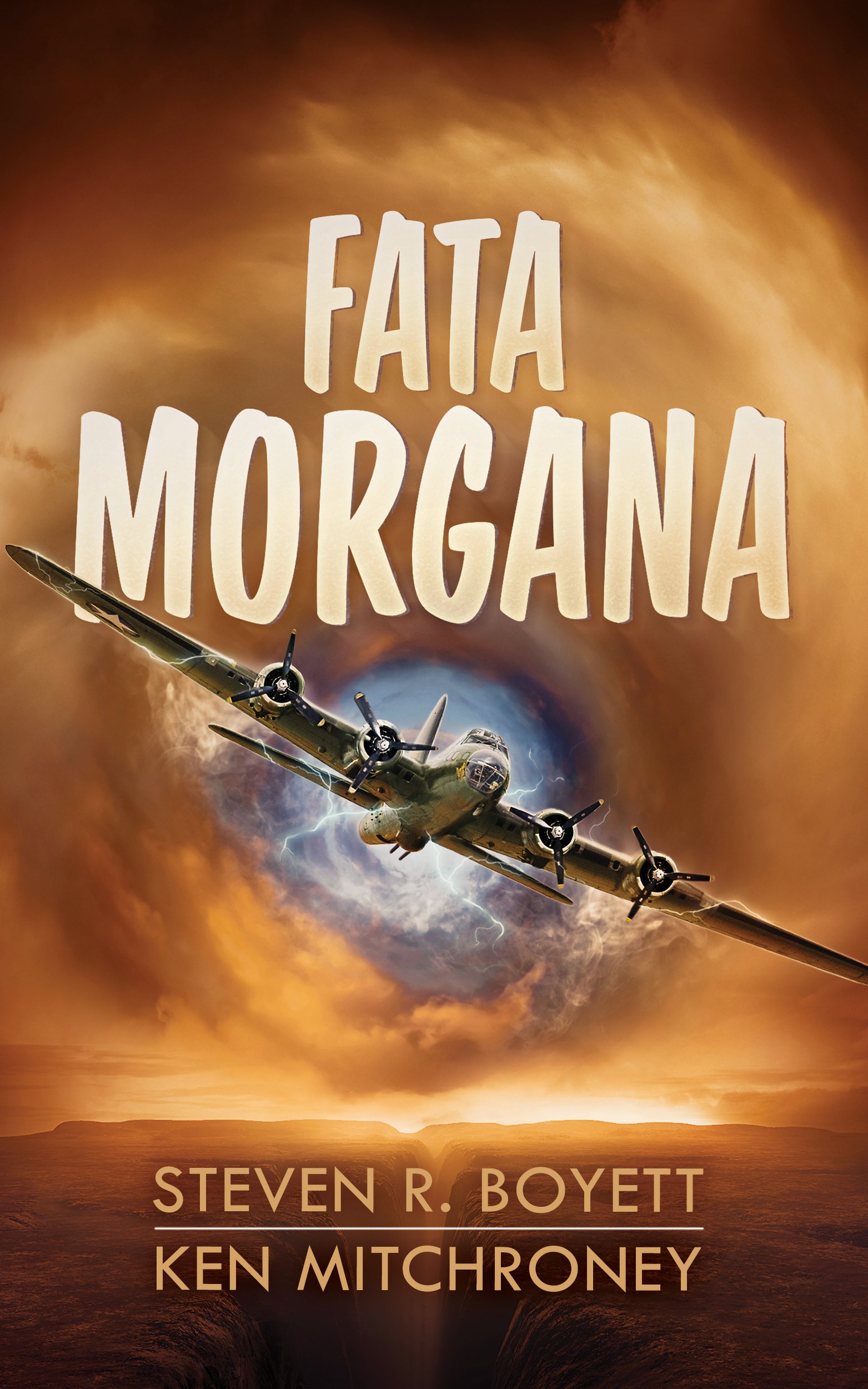 Fata Morgana is part WWII adventure, part science fiction, and part love story. Pub date is June 13, 2017, but you can pre-order it here. Bound galleys have gone out for blurbs, and we’re already getting back some terrific responses.
Fata Morgana is part WWII adventure, part science fiction, and part love story. Pub date is June 13, 2017, but you can pre-order it here. Bound galleys have gone out for blurbs, and we’re already getting back some terrific responses.
We’ll post the opening chapter in a few weeks, and we’ll be giving away signed Advance Reader Copies after that, so stay tuned!
FATA MORGANA – New Novel Sold
 I’m happy to announce that Fata Morgana, the novel I’ve worked on with Ken Mitchroney for about the last three years, sold to Blackstone last week. It’ll be available in hardcover, trade paperback, e-book, and audiobook formats. No pub date yet, but I’ll certainly be posting as we move forward.
I’m happy to announce that Fata Morgana, the novel I’ve worked on with Ken Mitchroney for about the last three years, sold to Blackstone last week. It’ll be available in hardcover, trade paperback, e-book, and audiobook formats. No pub date yet, but I’ll certainly be posting as we move forward.
This novel involved a huge amount of research — at one point I was pretty sure I could load & operate a B-17F ball gunner turret — but I think it was worth it.
Here’s the draft marketing copy to give you some idea what Fata Morgana is about.
At the height of WWII a Flying Fortress vanishes from a deadly bombing mission over flak-filled German skies—and leaves ten crewmen stranded with the final outcasts of a desolated world.
Caught between bitter enemies competing for their bomber, the vast power that has brought them here for its own purposes, and a terrifying living weapon obsessed with their destruction, Capt. Joe Farley encounters wonder and terror—and a love decreed by fate—as he fights to recover his stolen Flying Fortress and get his men back home.
Fata Morgana—the epic novel of love and duty at war across the reach of time.
Woo hoo!
Fan Trailer for ARIEL
This was a pleasant surprise to discover today. I think it’s wonderfully done, and captures the book quite well. Thanks, Shawndel Mann! I’m enormously flattered.
Collaborators
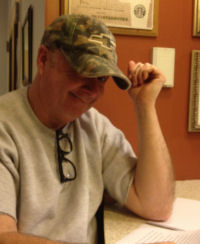
I’ve worked on many projects with Ken Mitchroney in the nearly 30 years we’ve been friends. When I wrote a draft of Toy Story 2 at Pixar, he was Head of Story for the project. I wrote an issue of his Space Ark comic book, and for a year I worked for Marvel writing Ren & Stimpy comics, most of which Ken drew. We once worked on, I swear to god, a set of Looney Tunes baseball cards for Chuck Jones.
Ken & I have written two feature-length screenplays together. We’ve pitched a lot of movies to a lot of nodding heads. (They listen, and then at the end they lean forward and say things like, “Well — Jeffrey doesn’t like cats.”) We have one of those finish-each-other’s-sentences creative brainshares that makes collaborating a lot more fun than sitting in a room by myself making stuff up. Ken & I have very different sensibilities, but somehow they dovetail almost seamlessly.
For years we’ve had a project we’ve wanted to do, called Fata Morgana. We thought it was a pretty commercial idea, and I figured I would enjoy writing a book that was just … well, fun. A big summer blockbuster adventure. Something to make my agent smile and say, “Now that’s what I’m talking about.”
Then Ken finished a great gig directing a season of the popular Annoying Orange TV show and found himself with a stretch of time before he’d likely be back in L.A. on some new project. So he said, Hey, let’s do Fata Morgana. I said Hellyeahs.
Two years later the novel is nearly finished. In terms of research and plotting, it’s the hardest thing I’ve ever done. So much for cranking out a summer blockbuster.
This may help explain my >year absence from posting (I had to hire someone to sift through the barrage of emails that arrived because I stopped blogging. Oh,. no, wait — that was a dream I had.)
Terminator: The Remix
The Terminator: Genisys trailer interests me because it seems a major indication of Hollywood embracing remix culture. The movie seems to be a clever take on the standard reboot: Rather than simply reapproach or update the canonical material, T:Gsys considers the audience’s familiarity with the source material (particularly the first two movies) to be a given, and recontextualizes their tropes and iconography to subvert and surprise. It uses their original source material to tell a different story.
If that ain’t a remix, I dunno what is.
A good remix stands on its own while paying hommage to its source. You want to think that you can appreciate a remix on its own merits, but any familiarity with the source material renders such judgments difficult. In the same vein, it’s difficult to consider T:Gsys apart from Terminator and T2: Judgement Day, but I think that’s precisely the point — you aren’t supposed to. Rather, the first two movies inform this telling. In this version we have events already familiar to us from earlier versions, often inverted here, whose express objective is to prevent the occurrence of those very events.
In the Terminator series, the device that makes this recontextualization more than a simple act of arrogance or exploitation is the theory of alternate timelines. It’s a terrific justification. Rather than reshuffling and redesigning the deck of already-known moments because of hubris or greed (It wasn’t broke, but we’re fixing it!), the assumption here is that the timeline itself is broken, and this movie is fixing it. Doing that requires different approaches to familiar events.
None of this necessarily means that T:Gsys will be any good. But the approach itself is fascinating, and the fact that considerable effort and expense have gone into it is, I think, significant. Offhand I can’t think of another cinematic remix at the studio level.
I’ve long held that the remix is the metaphor for art and digital technology of the early 21st Century, and I think T:Gsys has the potential to be a watershed moment in the re-envisioning of approaches to earlier films. As with Fred Astaire dancing with vacuum cleaners or Audrey Hepburn shilling chocolate from beyond the grave, undoubtedly there will be lots of debate about whether or not this approach is a good thing. But as with any creative endeavor, the answer to that will lie not in any inherent goodness or badness of the approach, but in whether or not the work itself was done well.
LitCrawl Hella Fun
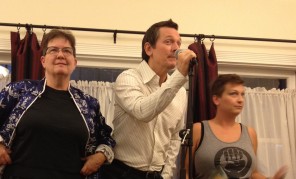
This year’s LitCrawl was big moby fun, and attendance at the incomparable Borderlands Bookshop was standing room only despite a BART strike that created havoc with travel into San Francisco and jammed up the available city public transportation.
The crowd for this event always amazes me — unfailingly polite, attentive, and responsive. You couldn’t ask for a better audience. Ellen Klages read from a story currently available at tor.com. She has a great ear for dialog and a real talent for voices, and I thoroughly enjoyed her reading. Allison Moon did a (ahem) bang-up job reading a lesbian werewolf sex scene that managed to be more tasteful than pornographic, though I couldn’t help referring to it as Fifty Shades of Gray Wolf.
I usually record my performances, but I didn’t this time because the piece, “I’m Sorry to Have to Tell You This,” is already available on my Media page. Normally I’d do something new for LitCrawl, but I’ve been traveling and just haven’t had time to learn a new piece.
This year’s LitQuake after party was held in a much smaller (albeit nicer) venue than last year’s party. It was DJ’d by Gavin Hardkiss, whose work I’ve heard for quite some time now. I got a kick out of that because I was the DJ for last year’s after party. It was fun to be on the other side of the decks for a change, though I admit to being jealous because the venue’s setup was much nicer than what was available to me last year. Wahh.
I stumbled back to my apartment at about 5 a.m., so I think I can safely say that a Good Time Was Had by All.
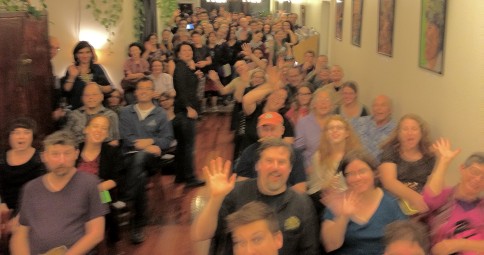
Reading @ LitCrawl SF
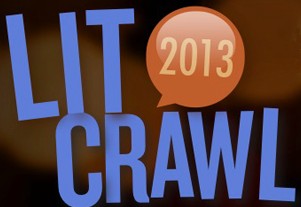 Back from two weeks in Ibiza (Space closing party, hellyeh) and a week in Florida (um, yuck), and I’m rushing to catch up and to prepare for my performance at this year’s epic LitCrawl event.
Back from two weeks in Ibiza (Space closing party, hellyeh) and a week in Florida (um, yuck), and I’m rushing to catch up and to prepare for my performance at this year’s epic LitCrawl event.
LitCrawl is the capper to the week-long LitQuake festival, which features readings, panels, and other literary events throughout San Francisco. LitCrawl is the book-lover’s equivalent of a massive pub crawl, in which 10 or 15 thousand people scurry from one event to the next on a Saturday night in the Mission district.
Last year I did my thing on opening day of LitQuake and then DJ’d the closing party (the mix, “Lit Up,” is here if you want to stream, here if you want to download it). This year I’m performing at 8:30 PM at Borderlands Books Cafe (866 Valencia Street, San Francisco, CA 94110 [map]). The hour is titled “Fantastic Creatures and Extinction Events” (official page here). Also reading are Ellen Klages, Allison Moon, and Diana Orgain. (Apparently Annalee Newitz had to cancel).
Naturally BART went on strike at midnight last night, making the event enormously problematic for me and thousands of others. Parking in the Mission is nearly impossible during LitCrawl. Adding thousands more vehicles to San Francisco on a Saturday makes it a full-on nightmare. I have to say that, after seeing what subway drivers in Manhattan routinely endure a few weeks ago, I have very little sympathy for BART operators and their current demands.
MLK – repost
NOTE: This entry was originally posted in January 2010. I’m reposting it today in honor of the 50-year anniversary of King’s historic speech in Washington.
———————————————

Some years ago while auditioning samples for compositions, I was listening to pieces of Martin Luther King’s iconic “I Have a Dream” speech and was astonished to realize that that the speech is — from start to finish and without variation — 125 beats per minute for over 15 minutes.
I have always thought that the “Dream” speech is about the most passionate, important, lyric, and beautifully constructed stretch of oratory imaginable. The realization that it’s also right on tempo caused me to start listening to it as a musical construction. It has a nearly symphonic structure, with distinct movements. And of course there’s that astonishing finish.
I wanted to compose something that would underscore the speech’s musicality — a simple piece that wouldn’t call attention to itself or stand independently of the speech, but act as a bed to illustrate the structure and lyric beauty of King’s amazing words.
I did absolutely no editing to the speech beyond toning down some of the applause and EQing it a bit for clarity. It runs in “MLK” exactly as it was recorded, from start to finish, and the music is composed around it. All stops, breaks, returns, emphases are exactly as Rev. King delivered them.
After many listenings my appreciation for Rev. King’s words (and passion, and hope) has only deepened, and the demonstration of their musicality fills me with a childlike wonder. I hope that you are as moved and astonished by the beauty and depth of this speech as I continue to be.
Download: Steve Boyett – “MLK”
Don’t be this guy
Kongar-ool Ondar 1962-2013
 A few days ago I learned of the death of Kongar-ool Ondar on July 29 during emergency surgery following a massive brain hemorrhage in Kyzyl, Tuva.
A few days ago I learned of the death of Kongar-ool Ondar on July 29 during emergency surgery following a massive brain hemorrhage in Kyzyl, Tuva.
Ondar was a master of the art of what Westerners call Tuvan throat-singing. He attained global prominence by a very odd route: When physicist Richard Feynman passed himself off as a Tuvan singer in an attempt to travel to Tuva (technically a Russian republic). Most Americans’ first exposure to Tuvan throat-singing was a recording played briefly during the Nova episode Richard Feynman: The Last Journey of a Genius. There was a bit of a sensation for it, resulting in several Tuvan artists (most notably Ondar and the band Huun Huur Tu) attaining international prominence.
There was a period in my life when activities oddly related to regulated breathing were very important: Throat singing, didgeridoo, and yoga. During this time I started a Yahoo Throat-Singing Group (when Yahoo was the most prominent of such online groups), and that led to many unexpected adventures, some of which I discussed here.
I met Ondar twice. The first time was at a performance at the L.A. Public Library downtown, where I was extremely fortunate to see him perform with Paul Pena, a blind blues artist whose adventures traveling to Tuva are detailed in the wonderful documentary Genghis Blues. The second time was after a screening of Genghis Blues in Pasadena. Both times he was gracious, and had astonishing charisma. I never saw him — live, on television, or recorded — when he didn’t radiate joy.
Ondar performed on David Letterman, and with a truly eclectic number of musicians, including Paul Pena, Frank Zappa and The Chieftains (!), Bela Fleck and the Flecktones, and more. In 1993 he rode and performed in the Rose Bowl Parade in Pasadena.
In his own country Ondar was a national treasure. He was a much-loved ambassador for his country and its unique traditional music. I am very saddened by his early death, but it makes me happy that his music lives on. It’s an example of the astonishing variety and ability of our species.
Bald on Night Mountain
Last March I cut off all my hair, kind of on a whim. It’s all grown back now.
I don’t think I’ll be doing that again.
I suspected my head would look a bit like a badly peeled potato, but I hadn’t realized just how much my head had got the living shit knocked out of it over the years. Including a divot scooped in the back that you’d think would have rained on my autonomic parade. I blame my sister’s headboard. Though, in all fairness, I did used to break bricks & boards with the poor sad abused brainbucket, and that couldn’t have helped the whole pleasing-aesthetic-shape thing much.
The thing that bothered me most about it wasn’t getting sunburned, or being cold (though wind on it felt weird). It was that it’s all stubbly within a day, and when you put on a T-shirt it catches on it like velcro. I hated that feeling.
Epistles
I received your communication indicating your concerns about the two National Security Agency programs that have been in the news recently. I appreciate that you took the time to write on this important issue and welcome the opportunity to respond.
First, I understand your concerns and want to point out that by law, the government cannot listen to an American’s telephone calls or read their emails without a court warrant issued upon a showing of probable cause. As is described in the attachment to this letter provided by the Executive Branch, the programs that were recently disclosed have to do with information about phone calls – the kind of information that you might find on a telephone bill – in one case, and the internet communications (such as email) of non-Americans outside the United States in the other case. Both programs are subject to checks and balances, and oversight by the Executive Branch, the Congress, and the Judiciary.
As Chairman of the Senate Intelligence Committee, I can tell you that I believe the oversight we have conducted is strong and effective and I am doing my level best to get more information declassified. Please know that it is equally frustrating to me, as it is to you, that I cannot provide more detail on the value these programs provide and the strict limitations placed on how this information is used. I take serious my responsibility to make sure intelligence programs are effective, but I work equally hard to ensure that intelligence activities strictly comply with the Constitution and our laws and protect Americans’ privacy rights.
These surveillance programs have proven to be very effective in identifying terrorists, their activities, and those associated with terrorist plots, and in allowing the Intelligence Community and the Federal Bureau of Investigation to prevent numerous terrorist attacks. More information on this should be forthcoming.
- On June 18, 2003, the Director of the National Security Agency (NSA) testified to the House Intelligence Committee that there have been “over 50 potential terrorist events” that these programs helped prevent.
- While the specific uses of these surveillance programs remain largely classified, I have reviewed the classified testimony and reports from the Executive Branch that describe in detail how this surveillance has stopped attacks.
- Two examples where these surveillance programs were used to prevent terrorist attacks were: (1) the attempted bombing of the New York City subway system in September 2009 by Najibullah Zazi and his co-conspirators; and (2) the attempted attack on a Danish newspaper that published cartoons of the Prophet Mohammed in October 2009 by U.S. citizen David Headley and his associates.
- Regarding the planned bombing of the New York City subway system, the NSA has determined that in early September of 2009, while monitoring the activities of Al Qaeda terrorists in Pakistan, NSA noted contact from an individual in the U.S. that the FBI subsequently identified as Colorado-based Najibullah Zazi. The U.S. Intelligence Community, including the FBI and NSA, worked in concert to determine his relationship with Al Qaeda, as well as identify any foreign or domestic terrorist links. The FBI tracked Zazi as he traveled to New York to meet with co-conspirators, where they were planning to conduct a terrorist attack using hydrogen peroxide bombs placed in backpacks. Zazi and his co-conspirators were subsequently arrested. Zazi eventually pleaded guilty to conspiring to bomb the NYC subway system.
- Regarding terrorist David Headley, he was also involved in the planning and reconnaissance of the 2008 terrorist attacks in Mumbai, India that killed 166 people, including six Americans. According to NSA, in October 2009, Headley, a Chicago businessman and dual U.S. and Pakistani citizen, was arrested by the FBI as he tried to depart from Chicago O’Hare airport on a trip to Europe. Headley was charged with material support to terrorism based on his involvement in the planning and reconnaissance of the hotel attack in Mumbai 2008. At the time of his arrest, Headley and his colleagues were plotting to attack the Danish newspaper that published the unflattering cartoons of the Prophet Mohammed, at the behest of Al Qaeda.
Not only has Congress been briefed on these programs, but laws passed and enacted since 9/11 specifically authorize them. The surveillance programs are authorized by the Foreign Intelligence Surveillance Act (FISA), which itself was enacted by Congress in 1978 to establish the legal structure to carry out these programs, but also to prevent government abuses, such as surveillance of Americans without approval from the federal courts. The Act authorizes the government to gather communications and other information for foreign intelligence purposes. It also establishes privacy protections, oversight mechanisms (including court review), and other restrictions to protect privacy rights of Americans.
The laws that have established and reauthorized these programs since 9/11 have passed by mostly overwhelming margins. For example, the phone call business record program was reauthorized most recently on May 26, 2011 by a vote of 72-23 in the Senate and 250-153 in the House. The internet communications program was reauthorized most recently on December 30, 2012 by a vote of 73-22 in the Senate and 301-118 in the House.
Attached to this letter is a brief summary of the two intelligence surveillance programs that were recently disclosed in media articles. While I very much regret the disclosure of classified information in a way that will damage our ability to identify and stop terrorist activity, I believe it is important to ensure that the public record now available on these programs is accurate and provided with the proper context.
Again, thank you for contacting me with your concerns and comments. I appreciate knowing your views and hope you continue to inform me of issues that matter to you. If you have any additional questions or concerns, please do not hesitate to contact my office in Washington, D.C. at (202) 224-3841.
Sincerely yours,
Dianne Feinstein
United States Senator
——————————————————————————————————–
From: Steven R. Boyett
Sent: Wednesday, July 31, 2013 12:27 PM
To: ‘senator@feinstein.senate.gov‘
Subject: U.S. Senator Dianne Feinstein responding to your message
Ms. Feinstein:
I feel that you are acting against the very principles you have been elected to uphold. Restricting liberty to establish security is a devil’s bargain, sanctioned by corporations motivated by shareholder profit, enabled by sustained government contracts, and perpetuated by massive financial influence over elected officials.
Your justifications enumerated below are simply that: justifications. Your claim that warrantless surveillance will not be conducted because it is illegal has not only been demonstrated to be patently false on a wholesale level inconceivable even a decade ago, it is an alarmingly naive position for the Chairman of the House Intelligence Committee to take. Edward Snowden’s revelations have made it painfully clear that there is a vast difference between what the law permits and what security operatives routinely do. For you to abet this function is wholly shameful.
I have voted for you in the past. I will not do so again.
–steven boyett
Metabooking
The current crop of enhanced e-books falls sadly short of the medium’s spectacular capabilities. Mostly they provide extras: Interviews, author readings, the audiobook, maybe a game. Like bonus material on a DVD, but without deleted scenes, boooo! Some of it is useful: Timelines, maps, etc. But there’s very little that enhances a reader’s enjoyment and understanding of the text itself. More importantly, there’s no model, modular approach to bringing such enhancements to the text.
Certainly some books have taken creative advantage of the medium. Richard Dawkins’ The Magic of Reality springs to mind. But most efforts have been primitive, gimmicky, or misdirected. One “cutting-edge” approach is indistinguishable from the “choose-your-own-adventure” books of the 70s & 80s, apart from the reader not having to turn actual pages to get to the chosen part. Readers made it plain then that they want the writer to choose the adventure. If I can choose it myself, then the events that lead up to the end are, by definition, arbitrary. I certainly don’t feel I’ve paid to be in the hands of a good storyteller.
Other approaches are faring similarly. Most readers don’t care how many other readers have highlighted a particular passage. Most don’t want to interrupt their literary immersion to chat about a scene they’re in the middle of. Most are quickly bored with watching a graphic move.
The resounding verdict is that what readers like to do is read, and distracting and superfluous add-ons are mostly unwelcome. (I except the value of such enhancements in children’s books.) Book enhancements need to be inimical. They need to bring something to the text beyond the appearance of a desperate need to keep a reader’s attention. This won’t surprise enthusiastic readers, and it’s a shame that it is surprising publishers.
I would like the option to release (and read) novels as wikis. I’m interested in the opportunity to create what are essentially linked, flexible, self-updating, multimedia versions of annotated books. I’d like a layered approach of well-integrated functions that can show me the real-world settings of fictional events; explain technical or historical references; provide definitions; discuss allusions in, or influences on, the text; give biographical information that provides insight into an author’s choices and themes; play a referenced song. I would like a platform that can provide this for any book I read (so long as there are readers willing to contribute material). And I’d like it even better if this platform was open source.
These abilities would let a book live and breathe beyond its pages, without interfering with the immersive, methodical, linear, and private process that is reading.
The first time through I might not use any of these options. But on re-reading, the chance to have more than my prior exposure informing the novel is very exciting to me. There are many authors whose density, allusion, humor, historical immersion, complexity, and even obscurity would be made more accessible through the application of such layers, without affecting a comma’s worth of their prose, or my enjoyment of it. I think of how much more juice might be squeezed out of Homer, Dante, Faulkner, Joyce, Hemingway, Samuel R. Delany, Cormac McCarthy, Umberto Eco, David Foster Wallace. Doubtless you have your own list.
I have every confidence that this is where e-books will head. Until then, third-party approaches seem to be a good stopgap. I’m talking about websites that act as “read-alongs,” book-specific wikis with user-provided explanations, definitions, associations, maps, media, etc. I am surprised that I have found so few.
Book Drum is a good one, I think. They have a nice selection of user-provided book “profiles,” from Milan Kundera to Homer to (ahem) V.C. Andrews. To create or edit a profile you have to sign up, but the book profiles themselves are accessible to anyone. The quality of the entries is uneven, but that’s the nature of the beast. I found the profile of Cormac McCarthy’s The Crossing to be startlingly well-researched and illuminating, and I was quite grateful for the work that contributor Gordon Knox put into it. I’ve read that novel five or six times, yet here was a trove of insight and information for me.
I like to think that someone will get form & function right enough that one such site will become the go-to location for — oh, let’s call it metabooking. Heck, if such a site were successful enough — the Facebook of metabooking — maybe it could be ported as a free addon to your ebook purchase. Maybe your Kindle would give you the option of implementing it.
Enjoy Your 4th
Richard Matheson – 1926-2013
Learning to Fly
 I spent most of a recent Friday crawling around the Nine Oh Nine, a B-17 Flying Fortress, with Ken Mitchroney, my writing partner on Fata Morgana. Besides being a ton o’ fun, it was invaluable for the novel, and educational in some unexpected ways.
I spent most of a recent Friday crawling around the Nine Oh Nine, a B-17 Flying Fortress, with Ken Mitchroney, my writing partner on Fata Morgana. Besides being a ton o’ fun, it was invaluable for the novel, and educational in some unexpected ways.
I’ve often mentioned that I’m a fiend for research, I think because I usually write about impossible things. The advantage is that it lends credence to what’s essentially an unbelievable idea. The disadvantage is that gritty realism also shines a harsher light on the impossible elements, forcing you to work harder to make them believable and dovetail them into your depictions of the familiar.
 Ironically, often the more specific you are, the more you open yourself up to argument. It’s not difficult to believe the line, “He rode the horse across the desert.” But if I write in detail about riding a horse across a desert, and get one of those specifics wrong, the whole thing falls apart. (I wonder if that’s why fantasy fiction has traditionally been so flowery and general: it’s trying to lull you into acceptance, to make you focus on the ornate icing because in truth there’s not much cake. Hmm.) I think the advantages outweigh the disadvantages, because when it works, you don’t just accept that someone rode a horse across the desert, you rode it yourself.
Ironically, often the more specific you are, the more you open yourself up to argument. It’s not difficult to believe the line, “He rode the horse across the desert.” But if I write in detail about riding a horse across a desert, and get one of those specifics wrong, the whole thing falls apart. (I wonder if that’s why fantasy fiction has traditionally been so flowery and general: it’s trying to lull you into acceptance, to make you focus on the ornate icing because in truth there’s not much cake. Hmm.) I think the advantages outweigh the disadvantages, because when it works, you don’t just accept that someone rode a horse across the desert, you rode it yourself.
 In my case, I have be careful not to over- compensate. It’s easy to belabor the concrete details as courtroom evidence that these impossible events did in fact take place. It’s something I look for when I revise.
In my case, I have be careful not to over- compensate. It’s easy to belabor the concrete details as courtroom evidence that these impossible events did in fact take place. It’s something I look for when I revise.
By now I’ve read a ton of books and watched a ton of video related to B-17s. the Eight Air Force, and the European Theater in 1943. Yet no amount of research is a substitute for experience. To crawl around inside that bomber, smell the grease and 108 octane, feel first-hand how crammed together those young men were, is to come away with a handful of One True Things that we wouldn’t have found without being there. Things that give the authenticity we’re looking for.
Still — I’ve promised Ken there won’t be a pilot’s manual in the novel. I think I’ve learned the difference between making a reader believe someone can fly a bomber, and teaching the reader to fly the damn thing himself.
Fata Morgana is about halfway done, and we’re hugely happy with it. Even better, our agent is hugely happy with it.

Atomic Armada
My friend Adrian Smith is a wreck diver and videographer who has started a Kickstarter campaign to fund an expedition to Bikini Atoll in the Pacific in order to document the warships sunk by a U.S. atomic blast in 1946. These WW2-era ships are the only ones ever to be exposed to close-range atomic blast (click the pic for a mind-blowing sense of how close).
To give you an idea of what these ships were exposed to, take a look at the water column of the mushroom cloud in this picture (or, even better, in this one). See the dark blotch on its lower right? That’s an aircraft carrier, lifted by the blast and standing on end.
Let me say that again. That’s an aircraft carrier. Lifted by the blast. And standing on end.
Among the sunken wrecks are the carrier Saratoga, the battleship Yamamoto (the flagship from which the Pearl Harbor attack was launched), the German battleship Prinz Eugen (which assisted the Bismark in sinking the USS Hood), and the U.S. submarine Apogon.
No comprehensive documentary exists of these historic vessels, and in recent years their erosion has accelerated. I think it’s very cool that Adrian is trying to get this documentary made. Here’s the Atomic Armada website. Fingers crossed for the expedition!
Name your poison
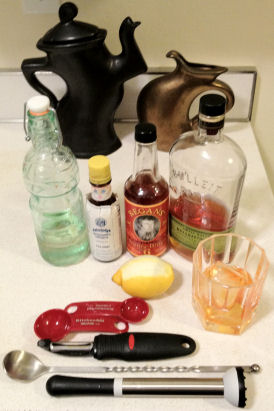
My favorite drink these days is a variation on a pre-Prohibition-era drink called a Whiskey Cocktail. It’s based on Jennifer Colliau’s recipe from Small Hand Foods.
The cocktail’s supposed to be made with bourbon (Buffalo Trace is recommended), but I use Bulleit small-batch rye. The Buffalo Trace has a lot of body, the Bulleit has a lot of character. It’s a preference thang.
Here’s the recipe, if you’re curious. Ingredients are listed in their pictured order, left to right.
- 1/4 oz simple syrup (1:1 sugar-to-water ratio)
- 1 dash Angostura bitters
- 1 dash orange bitters
- 2 oz. Bulleit rye (green label) or Buffalo Trace bourbon
- 1 lemon peel
- Add simple syrup and bitters to an old-fashioned glass.
- Add lemon peel and muddle moderately to release the oils.
- Add rye (or bourbon).
- Add large ice cubes (I use either the Tovolo King cube mold or the amazingly cool Tovolo sphere ice balls).
- Stir for 15-20 seconds.

It’s a tasty, sipping drink. They do sneak up on you, though.
Red, Inc.
How do we know that Steve’s working on a novel?
Because his red pens are running out of ink.
I knew when I said, “Hey, Ken, let’s write a book together!” that I should have had the foresight to say, “Hey, Ken, let’s write and edit a book together!”
The sad, perverted truth, though, is that I like this part.
(And yah, it’s clickable if you’re morbidly curious about my editorial self-evisceration. Good luck reading my handwriting, though — I could write prescriptions, I tell ya.)
Rolling Sevens
My music podcasts, Podrunner and Groovelectric, turn seven in a week. No way I would have believed I’d keep doing them this long, much less that they would have remained so popular.
 Groovelectric remains my favorite simply because, being a straight-up music mix series, it represents what I do, and love, and attempt, as an electronic music DJ. Since it debuted in February 2006, it’s usually been in iTunes’ Top 100 music podcasts.
Groovelectric remains my favorite simply because, being a straight-up music mix series, it represents what I do, and love, and attempt, as an electronic music DJ. Since it debuted in February 2006, it’s usually been in iTunes’ Top 100 music podcasts.
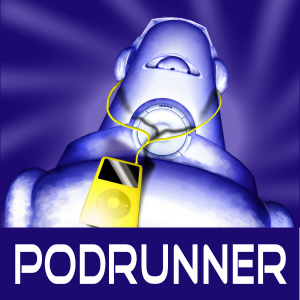 Podrunner has been hugely popular. The workout-music series has been a top iTunes podcast for seven years in a row, and a pacemaker literally and figuratively. There was nothing like it out there when it debuted, and I am enormously proud of its popularity and positive influence.
Podrunner has been hugely popular. The workout-music series has been a top iTunes podcast for seven years in a row, and a pacemaker literally and figuratively. There was nothing like it out there when it debuted, and I am enormously proud of its popularity and positive influence.
 I had to change the theme music for Podrunner, so I took the opportunity to dig out my old MIDI keyboard and brush up on my music production software before getting to work on new theme music. I’m pretty sure it’s the first thing I’ve composed in a decade.
I had to change the theme music for Podrunner, so I took the opportunity to dig out my old MIDI keyboard and brush up on my music production software before getting to work on new theme music. I’m pretty sure it’s the first thing I’ve composed in a decade.
Even with guitar-rig sampler kits, I couldn’t get a lead guitar sound I wanted for the opening notes. So I dug out my Univox imitation Les Paul guitar and played it myself. It’s the first time I’ve recorded guitar in at least 20 years. I had an absolute blast doing it.
The new Podrunner theme is below if you want to give it a listen or download it.
[UPDATE] I tweaked the track a bit, making it shorter & chunkier, and I EQ’d & mastered it to make it sound better overall. That’s now the file below.
[audio:http://www.djsteveboy.com/podrunner_theme.mp3]
Download
